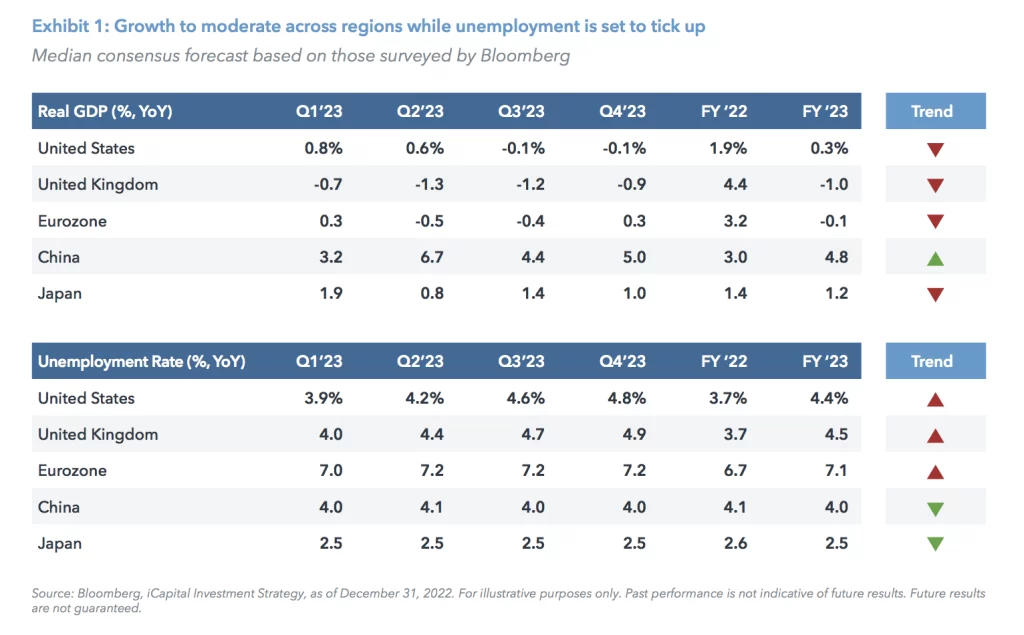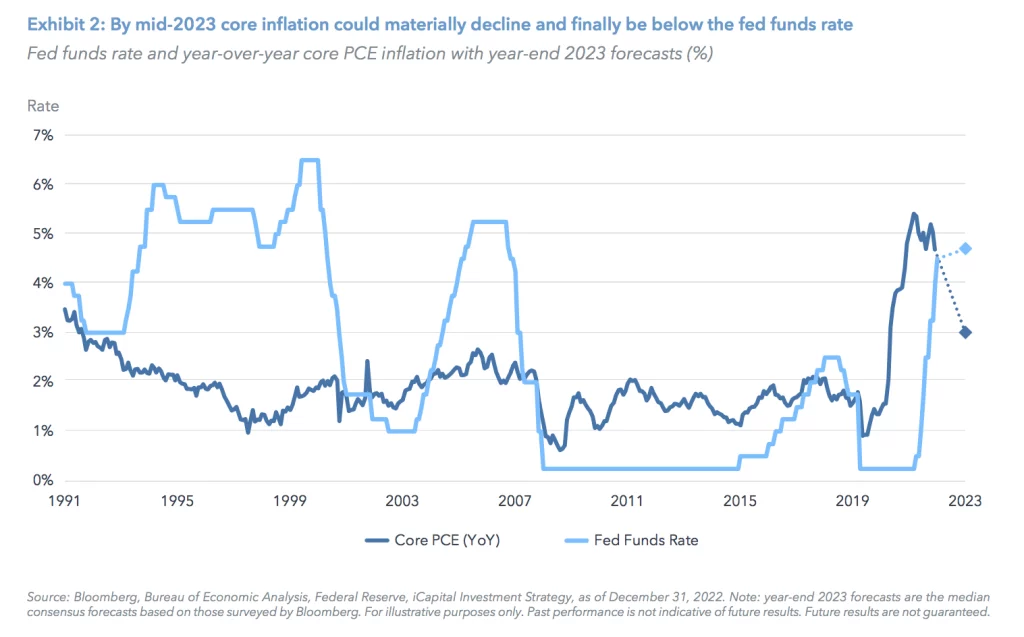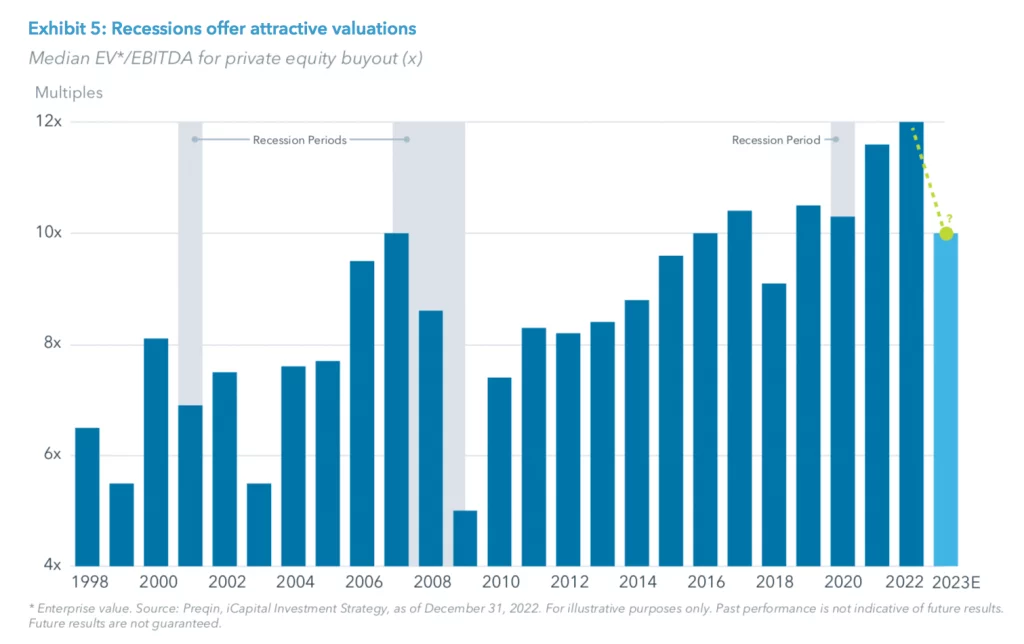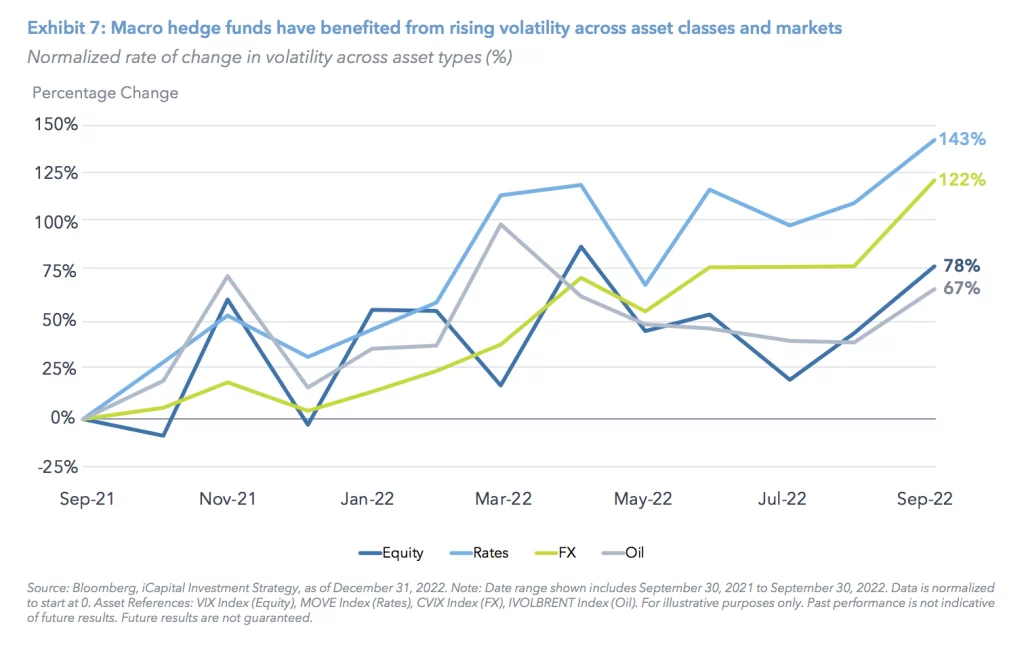A Fresh Perspective
The opinions are out and most everyone is bearish. We can’t deny that the growth outlook looks weak to start the year, but amid the gloom, we are focused on several reasons for optimism. The bottom line is last year was a reset, and historically many of the best vintage years occur after that type of a correction, making this year an attractive entry point into public and private market opportunities.
Yes, we think a growth slowdown and a still aggressive Fed could be a bad combination for markets in the first half of 2023 (1H ’23). However, inflation is showing signs of easing, and this should eventually prompt the Fed to stop hiking rates. As a result, we see a path for risk assets to recover in the second half of 2023 (2H ’23), creating a present opportunity for investors. Our view is that now is the time to commit — and we would be deliberate and methodical in deploying capital during 2023.
Market Overview
Although our calendars have turned to a new year, we expect a continuation of the main theme from late 2022 in 1H ’23 – a high fed funds rate (FFR) weighing on economic growth, but not yet bringing down inflation in a meaningful way. However, by 2H ’23, we anticipate the backdrop to be incrementally more positive. Inflation should moderate in a more convincing way, thereby allowing the Fed to consider easing rates (so long as labor market conditions and economic growth warrant it).
Should this scenario hold true, we would expect risk assets to correct again in 1H ‘23 before recovering in the back half and beyond. However, the good news for investors is that the reset in valuations is underway in a range of asset classes.1 And despite the challenging macro environment, investors now have the luxury of being both defensive and opportunistic. That said, we recommend a barbell strategy for 2023: on one end, cash, cash equivalents, and high-quality fixed income; on the other, emerging opportunities in distressed private credit, opportunistic real estate, buyout private equity, macro hedge funds, and structured investments (to capitalize on an eventual rebound in high quality tech, energy, and international stocks).
The First Half: A Shallow Recession
The ingredients for a slowdown/shallow recession have been in place for some time and are ready to be fully baked. Over the better part of 2022, the Fed aggressively hiked rates 425 basis points all while the economy — as measured by manufacturing, service, and housing — began showing signs of weakening.2 Amid this backdrop, real gross domestic product (GDP) growth turned negative for two consecutive quarters and the yield curve inverted.3 Historically, there is a period of time of around 15 months between the yield curve inverting and a recession occurring.4 By this logic, a shallow recession could be underway around the second quarter of 2023, though the slowdown will have already begun.
Looking ahead, as rates remain elevated, economic activity may slow further. Global GDP is expected to be 2.1% in 2023 (down from 3.2% growth in 2022), driven in part by recessionary concerns out of Europe and a slowdown in Japan.5 Domestically, U.S. GDP growth in 1H ‘23 is expected to be flat to marginally negative and end the second quarter of 2023 down -0.6% on a quarter- over-quarter annualized rate.6 In the labor market, jobless claims in the tech industry have started to inch up, and other industries will likely follow suit.7 As a result, the unemployment rate is forecast to rise to 3.9% and 4.2% in the first and second quarters of 2023, respectively, up from 3.7% in the fourth quarter of 2022.8 Additionally, the Fed is expected to keep its restrictive policy stance, which may pressure the economy to slow meaningfully in the months ahead.
The Second Half: A Silver Lining
Despite the muted outlook for 1H ‘23, there is a silver lining: An economic slowdown may bring inflation back under control. Consumers may trade down on goods; businesses may limit spending on services; and retailers may introduce markdowns. This, in turn, works to reduce the overall level of demand and, therefore, could reduce upward pressure on prices.
In fact, there are indications that these trends are emerging: many retailers have begun reducing prices; food and fuel prices have eased considerably; and inflation for both core goods and core services are now off their 2022 peaks.9 Shelter inflation, though still firm due to the lag effect between continuing-tenant and new-tenant rents, is also likely to soften as new rents are now in a multi-month decline.10
Meanwhile, the pace of job creation has declined, and intentions to raise wages have moderated, thereby limiting further inflationary pressures caused by a wage-price spiral.11
The personal consumption expenditures (PCE) index, a barometer for inflation, is expected to fall to 3.5% by the second quarter of 2023 and to 2.8% by year end, down from 5.7% at the close of 2022.12 Importantly, core PCE inflation, is also expected to trend lower, falling to 3.8% and 3.0% by the second and fourth quarters of 2023, respectively, from 4.7% in the fourth quarter of 2022.13
This anticipated fall in inflation gives the Fed greater discretion to cut rates, if needed. By the end of the first quarter of 2023, the fed funds rate is expected to finally surpass the falling rate of core PCE inflation.14 However, if core PCE inflation continues to fall further to the expected 3.8% rate by the middle of next year, and the fed funds rate remains at the market-implied 5%, a gap will open where nominal rates are above inflation.15 This, along with weakness in economic activity, is the point at which the Fed may consider the level of rates as being above sufficiently restrictive, and therefore may be justified in considering easing/cutting rates.
In Europe, rates will likely remain restrictive into the fourth quarter of 2023, as higher-for-longer inflationary pressures outweigh near-term growth concerns. Headline inflation is expected to moderate to 6.8% in the second quarter of 2023 and fall to 3.5% in the fourth quarter, down from 10.3% at the end of 2022. However, ongoing uncertainty around geopolitical tensions and energy supply instability pose an upside risk to inflation and downside risk to growth.
A Year of Opportunity Within 60/40
In 2022, we wrote about how the traditional 60/40 portfolio of equities and bonds was likely to be challenged by a confluence of factors, including slowing growth and elevated inflation.16 After being down 16.1% this past year — the worst since 2008 — we believe 2023 will prove to be a better year for this traditional 60/40 portfolio.17 This will largely be due to the fixed income sleeve, where we see a more attractive opportunity set arising from a potential reset lower in rates, following the run-up in 2022.
This is why the defensive part of our 2023 barbell playbook is focused on fixed income: (1) Cash and cash equivalents may pay 5% or above;18 (2) High quality investment grade (IG) credit and select high yield (HY) may yield 5.2% and 8.6%, respectively, and will likely continue to do so;19 (3) Long-duration U.S. Treasury securities are attractive on any back up in rates because we think the competing forces of inflation/tightening on one side, and potential recession on the other hand, may result in rates moving lower.
However, as we mentioned, the reset in valuations has been underway in a broad range of assets, and investors, while earning attractive carry in cash and fixed income, may want to focus the other end of their 2023 barbell portfolio on being cautiously opportunistic. Importantly, we see many opportunities in the alternative investments space to supplement the traditional equity and fixed income sleeves of a portfolio, which could potentially help enhance returns, provide diversification, or offer alternative sources of income. Our top five ideas for 2023 are: distressed private credit, buyout private equity, opportunistic real estate, macro hedge funds, and structured investments.
PRIVATE MARKETS
Idea #1: Private Credit: Distressed Investing
Over-levered companies have started to experience the challenges of higher borrowing costs and dimmer prospects to refinance debt. As a result, some of these borrowers could default. The projections for default rates for 2023 range from 3% to 5% for leveraged loans and high-yield bonds, respectively, in the United States and Europe. There is more than $4 trillion in notional value in these markets, leading to over $120 billion in opportunity for distressed investors in 2023, at the low end of the projections.20
We believe that the economic slowdown will continue until the end of the second quarter of 2023 resulting in a more prolonged opportunity set for distressed investing. We also observed that previous recessions, like the Global Financial Crisis (GFC) and the COVID pandemic, offered an attractive window for distressed investing opportunities. Investors may want to prioritize this segment of the market in 2023 to add diversification and enhance the return and income potential of their portfolios.
Idea #2: Private Equity: Buyout
As valuations begin to reset in the buyout market, we see an opportunity to acquire strong businesses at lower valuations than have been available in recent years. One of the major advantages of buyout investing is the ability to control/ influence the strategic direction of underlying businesses and create long-term value (e.g., enhance the return potential). This approach could be attractive in today’s environment where strong management teams, with the support of capital and advice from experienced buyout fund managers, can use their strength to gain market share and expand. Past cycles have shown that buyout performance improves during recessionary periods, and we believe that 2023 is poised to become one of the better vintage years for deploying capital.
Idea #3: Real Assets: Opportunistic Real Estate
As borrowing costs have risen, cracks have started to appear in the commercial real estate market, leading to declining valuations. Moreover, the economic slowdown could dampen the demand for real estate, adding further stress on pricing. This has led to a sell-off in the core and core-plus segments of the market. In our view, there are several factors that will likely create attractive buying opportunities in 2023: near-term refinancings at higher rates and less clarity on net income; a drop in valuations; ongoing secular shifts within property types; and portfolio rebalancing.
We believe experienced opportunistic real estate investors are likely to invest in properties where return potential is enhanced through improvements, rather than rent increases, which are more difficult to achieve in an economic downturn. Adding an allocation (or increasing an existing allocation) to opportunistic real estate could diversify growth options within a client portfolio.
HEDGE FUNDS
Idea #4: Macro
Against a challenging market backdrop, macro is one of the strategies that has continued to post strong returns in the hedge fund space. Macro fund managers typically take positions across asset classes and geographies, expressing their views in a relative value or directional construct to capture large market and price movements. Historically, macro funds have delivered attractive risk-adjusted returns with low correlation to traditional stocks and bonds, particularly during periods of market dislocation. An allocation to macro may improve overall portfolio results by providing diversification and meaningful downside protection.
It is our view that the outlook for the strategy remains favorable, given the uncertainty around some of the key drivers of macro performance, including interest rates, inflation, economic growth, and geopolitics. Disparate fiscal and monetary responses across geographies are adding further complexity to the market backdrop, resulting in higher levels of volatility across assets classes (see Exhibit 7). This may continue to provide an attractive opportunity set for macro managers to identify and structure trades which capitalize on this volatility.
STRUCTURED INVESTMENTS
Idea #5: Notes with Downside Protection
While we expect the market environment to remain challenging in the coming months, volatility and market moves in rates present opportunities for investors in the structured investments space. As short-term rates remain elevated, investors have the potential to lock in more attractive structured investment terms. The higher the rate offered for the bond component of a structured investment, the greater the likelihood to deploy that funding into the underlying options package, offering enhanced upside and/or downside protection. This is especially timely since rates could move lower across the curve, if the market begins to price in a Fed rate cut.
Thus, we think investors would be well positioned to lock in elevated rates now.
Moreover, as volatility is expected to continue in the coming months, larger premiums on options could also lead to improved structured investment terms. Protection offered in structured investments generally comes from selling put or call options. The S&P 500 12-month implied put volatility is in the 74th percentile over the last year and the 94th percentile over the last 10 years, making it relatively attractive to sell put options.21
Structured investments’ potential to take advantage of both downside protection and eventual upside participation is another reason to consider adding the strategy as a key portfolio tool in 2023. For example, if the stock market (notably international, energy, or technology sectors) retests the lows, investors may enter into an equity-linked strategy at a favorable level to capitalize on the dislocation and a potential recovery.
The past three years have taught us that there are no economic certainties, and increasing exposure to risk assets using structured investments with a downside buffer or barrier may allow for more room for error.
Investors can also gain structured investment exposure through professionally managed separate accounts, which may offer enhanced yield and diversification without the operational burdens of a single investment purchase and life cycle management.
MORE INSIGHTS
Stay informed about alternatives by visiting our Insights & Education page. You can also sign up to receive the iCapital Market Pulse blog and Beyond 60/40 Monthly Newsletter — our latest market insights and perspectives — direct to your inbox.
1. Source: Bloomberg, iCapital Investment Strategy, as of December 31, 2022.
2. Source: Bloomberg, iCapital Investment Strategy, as of December 31, 2022.
3. Source: Bloomberg, iCapital Investment Strategy, as of December 31, 2022.
4. Source: Bloomberg, iCapital Investment Strategy, as of December 31, 2022.
5. Source: Bloomberg, iCapital Investment Strategy, as of December 31, 2022.
6. Source: Bloomberg, iCapital Investment Strategy, as of December 31, 2022.
7. Source: Bloomberg, iCapital Investment Strategy, as of December 31, 2022.
8. Source: Bloomberg, iCapital Investment Strategy, as of December 31, 2022.
9. Source: Bloomberg, iCapital Investment Strategy, as of December 31, 2022.
10. Source: Zillow, Apartment List, BLS, iCapital Investment Strategy, as of December 31, 2022.
11. Source: Bloomberg, BLS, NFIB, iCapital Investment Strategy, as of December 31, 2022.
12. Source: Bloomberg, iCapital Investment Strategy, as of December 31, 2022.
13. Source: Bloomberg, iCapital Investment Strategy, as of December 31, 2022.
14. Source: Bloomberg, iCapital Investment Strategy, as of December 31, 2022.
15. Source: Bloomberg, iCapital Investment Strategy, as of December 31, 2022.
16. Note: 60% S&P 500 and 40% Bloomberg Aggregate is used to represent a traditional 60/40 portfolio.
17. Source: Bloomberg, iCapital Investment Strategy, as of December 31, 2022. Note: 60% S&P 500 and 40% Bloomberg Aggregate is used to represent a traditional 60/40 portfolio.
18. Source: Bloomberg, iCapital Investment Strategy, as of December 31, 2022.
19. Source: Bloomberg, iCapital Investment Strategy, as of December 31, 2022.
20. Source: J.P. Morgan, LCD, Acuity, Marathon Asset Management, LP. As of June 30, 2022.
21. Source: Bloomberg, as of December 14, 2022.
IMPORTANT INFORMATION
The material herein has been provided to you for informational purposes only by Institutional Capital Network, Inc. (“iCapital Network”) or one of its affiliates (iCapital Network together with its affiliates, “iCapital”). This material is the property of iCapital and may not be shared without the written permission of iCapital. No part of this material may be reproduced in any form, or referred to in any other publication, without express written permission of iCapital.
This material is provided for informational purposes only and is not intended as, and may not be relied on in any manner as, legal, tax or investment advice, a recommendation, or as an offer or solicitation to buy or sell any security, financial product or instrument, or otherwise to participate in any particular trading strategy. This material does not intend to address the financial objectives, situation, or specific needs of any individual investor. You should consult your personal accounting, tax and legal advisors to understand the implications of any investment specific to your personal financial situation.
ALTERNATIVE INVESTMENTS ARE CONSIDERED COMPLEX PRODUCTS AND MAY NOT BE SUITABLE FOR ALL INVESTORS. Prospective investors should be aware that an investment in an alternative investment is speculative and involves a high degree of risk. Alternative Investments often engage in leveraging and other speculative investment practices that may increase the risk of investment loss; can be highly illiquid; may not be required to provide periodic pricing or valuation information to investors; may involve complex tax structures and delays in distributing important tax information; are not subject to the same regulatory requirements as mutual funds; and often charge high fees. There is no guarantee that an alternative investment will implement its investment strategy and/or achieve its objectives, generate profits, or avoid loss. An investment should only be considered by sophisticated investors who can afford to lose all or a substantial amount of their investment.
STRUCTURED INVESTMENTS ARE CONSIDERED COMPLEX PRODUCTS AND MAY NOT BE SUITABLE FOR ALL INVESTORS. Please note that there is no public secondary market for structured investments. Although the issuer may from time to time make a market in certain structured investments, the issuer does not have any obligation to do so and market making may be discontinued at any time. Accordingly, an investor must be prepared to hold such investments until maturity. Any or all payments are subject to the creditworthiness of the issuer. Before investing in any product, an investor should review the prospectus or other offering documents, which contain important information, including the product“s investment objectives or goals, its strategies for achieving those goals, the principal risks of investing in the product, the product“s fees and expenses, and its past performance.
iCapital Markets LLC operates a platform that makes available financial products to financial professionals. In operating this platform, iCapital Markets LLC generally earns revenue based on the volume of transactions that take place in these products and would benefit by an increase in sales for these products.
The information contained herein is an opinion only, as of the date indicated, and should not be relied upon as the only important information available. Any prediction, projection or forecast on the economy, stock market, bond market or the economic trends of the markets is not necessarily indicative of the future or likely performance. The information contained herein is subject to change, incomplete, and may include information and/or data obtained from third party sources that iCapital believes, but does not guarantee, to be accurate. iCapital considers this third-party data reliable, but does not represent that it is accurate, complete and/or up to date, and it should not be relied on as such. iCapital makes no representation as to the accuracy or completeness of this material and accepts no liability for losses arising from the use of the material presented. No representation or warranty is made by iCapital as to the reasonableness or completeness of such forward-looking statements or to any other financial information contained herein.
Securities products and services are offered by iCapital Markets, an SEC-registered broker-dealer, member FINRA and SIPC, and an affiliate of iCapital, Inc. and Institutional Capital Network, Inc. These registrations and memberships in no way imply that the SEC, FINRA, or SIPC have endorsed any of the entities, products, or services discussed herein. Annuities and insurance services are provided by iCapital Annuities and Insurance Services LLC, an affiliate of iCapital, Inc. “iCapital” and “iCapital Network” are registered trademarks of Institutional Capital Network, Inc. Additional information is available upon request.
©2024 Institutional Capital Network, Inc. All Rights Reserved. | 2024.01















